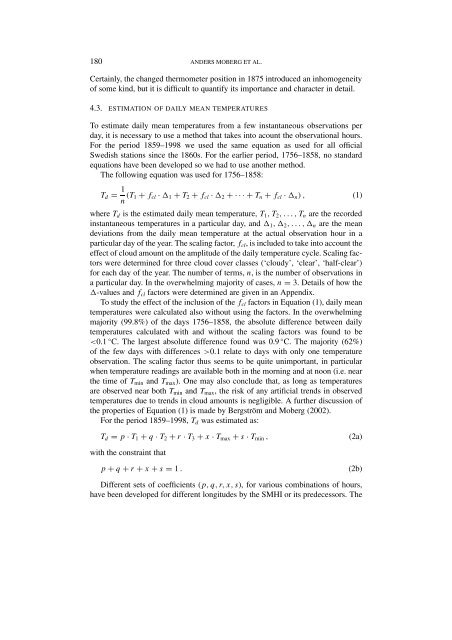DAILY AIR TEMPERATURE AND PRESSURE SERIES ... - BALTEX
DAILY AIR TEMPERATURE AND PRESSURE SERIES ... - BALTEX
DAILY AIR TEMPERATURE AND PRESSURE SERIES ... - BALTEX
Create successful ePaper yourself
Turn your PDF publications into a flip-book with our unique Google optimized e-Paper software.
180 <strong>AND</strong>ERS MOBERG ET AL.<br />
Certainly, the changed thermometer position in 1875 introduced an inhomogeneity<br />
of some kind, but it is difficult to quantify its importance and character in detail.<br />
4.3. ESTIMATION OF <strong>DAILY</strong> MEAN <strong>TEMPERATURE</strong>S<br />
To estimate daily mean temperatures from a few instantaneous observations per<br />
day, it is necessary to use a method that takes into acount the observational hours.<br />
For the period 1859–1998 we used the same equation as used for all official<br />
Swedish stations since the 1860s. For the earlier period, 1756–1858, no standard<br />
equations have been developed so we had to use another method.<br />
The following equation was used for 1756–1858:<br />
T d = 1 n (T 1 + f cl · 1 + T 2 + f cl · 2 +···+T n + f cl · n ), (1)<br />
where T d is the estimated daily mean temperature, T 1 ,T 2 ,...,T n are the recorded<br />
instantaneous temperatures in a particular day, and 1 , 2 ,..., n are the mean<br />
deviations from the daily mean temperature at the actual observation hour in a<br />
particular day of the year. The scaling factor, f cl , is included to take into account the<br />
effect of cloud amount on the amplitude of the daily temperature cycle. Scaling factors<br />
were determined for three cloud cover classes (‘cloudy’, ‘clear’, ‘half-clear’)<br />
for each day of the year. The number of terms, n, is the number of observations in<br />
a particular day. In the overwhelming majority of cases, n = 3. Details of how the<br />
-values and f cl factors were determined are given in an Appendix.<br />
To study the effect of the inclusion of the f cl factors in Equation (1), daily mean<br />
temperatures were calculated also without using the factors. In the overwhelming<br />
majority (99.8%) of the days 1756–1858, the absolute difference between daily<br />
temperatures calculated with and without the scaling factors was found to be<br />
0.1 relate to days with only one temperature<br />
observation. The scaling factor thus seems to be quite unimportant, in particular<br />
when temperature readings are available both in the morning and at noon (i.e. near<br />
the time of T min and T max ). One may also conclude that, as long as temperatures<br />
are observed near both T min and T max , the risk of any artificial trends in observed<br />
temperatures due to trends in cloud amounts is negligible. A further discussion of<br />
the properties of Equation (1) is made by Bergström and Moberg (2002).<br />
For the period 1859–1998, T d was estimated as:<br />
T d = p · T 1 + q · T 2 + r · T 3 + x · T max + s · T min ,<br />
(2a)<br />
with the constraint that<br />
p + q + r + x + s = 1 .<br />
(2b)<br />
Different sets of coefficients (p, q, r, x, s), for various combinations of hours,<br />
have been developed for different longitudes by the SMHI or its predecessors. The













